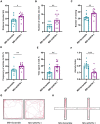Upregulation of Netrin-1 in the hippocampus mediates the formation of visceral hypersensitivity induced by maternal separation
- PMID: 35966013
- PMCID: PMC9366914
- DOI: 10.3389/fnmol.2022.908911
Upregulation of Netrin-1 in the hippocampus mediates the formation of visceral hypersensitivity induced by maternal separation
Abstract
Early adverse life events (EALs), such as maternal separation (MS), can cause visceral hypersensitivity, which is thought to be a key pathophysiological mechanism of irritable bowel syndrome (IBS). Previous studies mainly focused on EALs-induced visceral hypersensitivity in adulthood but did not consider that it may have occurred in the preadult period. We previously found that rats who experienced MS suffered from visceral hypersensitivity starting from the post-weaning period. Moreover, the hippocampus is considered to be critical in regulating the formation of visceral hypersensitivity induced by MS. But the underlying mechanisms throughout different life periods are unclear. In this study, behavioral tests, RNA-seq, lentiviral interference, and molecular biology techniques were applied to investigate the molecular mechanism in the hippocampus underlying MS-induced long-lasting visceral hypersensitivity. It was found that both visceral sensitivity and anxiety-like behaviors were significantly increased in MS rats in post-weaning, prepubertal, and adult periods, especially in the prepubertal period. Subsequently, RNA-seq targeting the hippocampus identified that the expression level of Netrin-1 was significantly increased in all periods, which was further confirmed by quantitative real-time PCR and Western blot. Knocking-down hippocampal Netrin-1 in the post-weaning period by lentivirus interference alleviated visceral hypersensitivity and anxiety-like behaviors of MS rats in the later phase of life. In addition, deleted in colorectal cancer (DCC), instead of neogenin-1(Neo-1) or uncoordinated (UNC5), was proved to be the specific functional receptor of Netrin-1 in regulating visceral hypersensitivity, whose upregulation may result in the most severe symptoms in the prepubertal period. Furthermore, the activation of the Netrin-1/DCC pathway could enhance long-term potentiation (LTP) in the hippocampus, probably via recruitment of the AMPA receptor subunit GluA1, which finally resulted in the formation of visceral hypersensitivity. These novel findings suggest that long-lasting over-expression of Netrin-1 can mediate visceral hypersensitivity and anxiety disorder from the post-weaning period to adulthood by activating DCC/GluA1 pathway in the hippocampus. Moreover, early intervention of Netrin-1 in the post-weaning period could lead to significant symptom relief afterward, which provides evidence that the Netrin-1/DCC/GluA1 signaling pathway may be a potential therapeutic target for the treatment of visceral hypersensitivity in clinics.
Keywords: DCC; GluA1; Netrin-1; hippocampus; maternal separation; visceral hypersensitivity.
Copyright © 2022 Wang, Duan, Zhan, Dong, Zhang, Chen, Sun and Xu.
Conflict of interest statement
The authors declare that the research was conducted in the absence of any commercial or financial relationships that could be construed as a potential conflict of interest.
Figures








Similar articles
-
Maternal Separation Induced Visceral Hypersensitivity from Childhood to Adulthood.J Neurogastroenterol Motil. 2017 Apr 30;23(2):306-315. doi: 10.5056/jnm16089. J Neurogastroenterol Motil. 2017. PMID: 28238254 Free PMC article.
-
Role of hippocampal circKcnk9 in visceral hypersensitivity and anxiety comorbidity of irritable bowel syndrome.Front Cell Neurosci. 2022 Nov 17;16:1010107. doi: 10.3389/fncel.2022.1010107. eCollection 2022. Front Cell Neurosci. 2022. PMID: 36467610 Free PMC article.
-
Hippocampal NR2B-containing NMDA receptors enhance long-term potentiation in rats with chronic visceral pain.Brain Res. 2014 Jun 27;1570:43-53. doi: 10.1016/j.brainres.2014.05.001. Epub 2014 May 10. Brain Res. 2014. PMID: 24824341
-
Netrin-1: An emerging player in inflammatory diseases.Cytokine Growth Factor Rev. 2022 Apr;64:46-56. doi: 10.1016/j.cytogfr.2022.01.003. Epub 2022 Jan 14. Cytokine Growth Factor Rev. 2022. PMID: 35082104 Review.
-
Role of Netrin-1 Signaling in Nerve Regeneration.Int J Mol Sci. 2017 Feb 24;18(3):491. doi: 10.3390/ijms18030491. Int J Mol Sci. 2017. PMID: 28245592 Free PMC article. Review.
Cited by
-
Early life stress induces irritable bowel syndrome from childhood to adulthood in mice.Front Microbiol. 2023 Oct 2;14:1255525. doi: 10.3389/fmicb.2023.1255525. eCollection 2023. Front Microbiol. 2023. PMID: 37849921 Free PMC article.
-
Investigation of the causal association between Parkinson's disease and autoimmune disorders: a bidirectional Mendelian randomization study.Front Immunol. 2024 May 7;15:1370831. doi: 10.3389/fimmu.2024.1370831. eCollection 2024. Front Immunol. 2024. PMID: 38774879 Free PMC article.
-
The interaction effect between childhood trauma and negative events during adulthood on development and severity of irritable bowel syndrome.BMC Gastroenterol. 2025 Apr 30;25(1):321. doi: 10.1186/s12876-025-03919-7. BMC Gastroenterol. 2025. PMID: 40307690 Free PMC article.
-
A nociceptive amygdala-striatal pathway for chronic pain aversion.bioRxiv [Preprint]. 2024 Feb 13:2024.02.12.579947. doi: 10.1101/2024.02.12.579947. bioRxiv. 2024. Update in: Sci Adv. 2025 Jul 25;11(30):eado2837. doi: 10.1126/sciadv.ado2837. PMID: 38405972 Free PMC article. Updated. Preprint.
References
LinkOut - more resources
Full Text Sources

